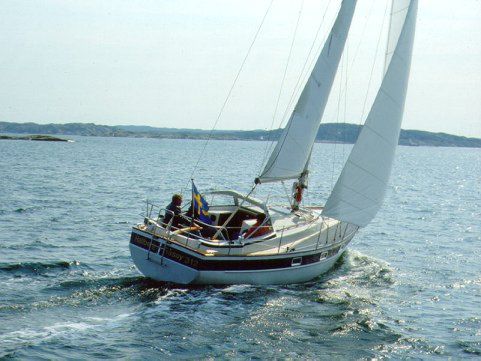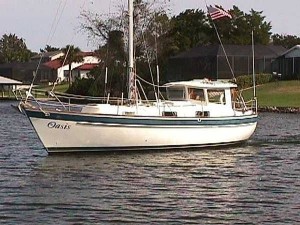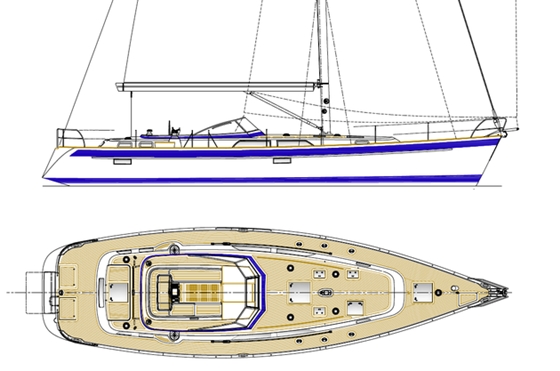Hallberg-Rassy 31: Bob Perry Design Review
Hallberg-Rassy 31: Feisty Passage Maker
While we all may dream of cruising in our big boats there are certain advantages to smaller cruising yachts. If I use that terrible term the "serious cruising" boat, we find the market fairly thin at lengths around 30 feet. What does "serious cruising" mean? I'm sure it was a term thought up by an ad agency, but it probably means a boat capable of cruising in areas where, if things begin to go wrong, you could find yourself in "serious trouble."
So the serious cruising boat should be a stout little survival capsule, overbuilt, over-rigged and designed with a particular balance of priorities. This balance of priorities may, at some times, appear to sacrifice comfort for safety or sacrifice speed for versatility or sacrifice interior volume for good sea manners. The ability to achieve this balance is what sets one designer apart from the others.
Conservative design is probably what is called for with this type of boat. By conservative, I don't mean that the boat should look like a long-lost Colin Archer design, nor should it disregard all modern performance-enhancing design features. I simply mean that the proportions will be moderate. Hallberg-Rassy has a track record of producing able offshore sailboats and the new German Frers-designed Hallberg-Rassy 31 appears to be very much in their established style. I think this boat makes a nice contrast to the Beneteau approach. The trick for the buyer is to match the boat style with his or her particular sailing and life style.
This hull shows distinctive Frers touches. The artfully drawn sheerline and the elevated counter aft are two that stand out. Freeboard has been kept low with headroom achieved by use of a relatively high cabintrunk. There is far less windage to the low sheer and high cabintrunk than there would be to just raising the sheer to gain the headroom.
The keel is a fin with bulbish tip. Note the strong break at the leading edge to leading edge fillet intersection. Note also that there is little if any fillet aft. The leading edge fillet break can be used to set up a vortex flow that isolates the flow over the hull from the over the fin. The hard break is used to amplify this distinction. The ballast is outside lead.
Note the relative location of keel and mast. There are both standard (draft 5 feet 7 inches) and shoal draft (4 feet 7 inches) keel options available. The rudder is a spade type that is partially balanced on a vertical stock. The D/L of this design is 280, which is right in the middle of medium by serious cruising boat standards.
Let's apply our BM/BT ratio to see how much beam is carried aft. If I once again fair out the radius at the sheer-to-transom intersection, I get 1.41, indicating that this design has less relative beam aft than the Beneteau or the Tripp 26, but more than the Tanton daysailer. The actual beam to length ration, using LOA and beam max, is 2.87; so at 31 feet LOA and 10 feet 10 inch beam, this is a beamy boat.
As we move to the accommodations, we can quickly see another balance element that, in this design, has been tipped toward safety and away from comfort. Note that the aft quarter double berth has been nipped off diagonally inboard to allow the rudderstock to extend to the deck. This will make tiller steering possible and will also allow an emergency tiller to be easily fitted if you choose to go with wheel steering. It also enlarges the available storage space in the lazarette. The rest of the layout is very straightforward.
The rig is another place where we see an interesting blend of performance, comfort and safety factors balanced. To begin with, Frers has chosen a fractional rig. No running backstays are shown to support the head of the genoa. Note also that the boat only has single spreaders. In my mind, these two details combine to indicate that a stout spar section was chosen. This, in conjunction with the aft swept spreaders, may be enough to let you avoid runners. The big main and small foretriangle mean that less importance will be placed on genoa selection through the wind range. It may also mean that this boat would balance under main alone if you found yourself overpowered. By bending the mast and altering the draft of the main you can either power up or depower the rig, depending upon your taste, without needing to resort to jib changes or to rolling up portions of your genoa.
There is always some crossover in design details between the racing fleet and the cruising fleet. The cruisers gave the racers self-tailing winches. The racers have been using fractional rigs with effectiveness for some time now and the cruisers have stayed with masthead rigs. Perhaps it's time to take a look at fractional rigs and the advantages they may offer cruisers. We are certainly in an age where everyone wants to get the most versatility out of their rig without having to go through an actual sail change. With this in mind, the fractional rig may have an advantage. Cruisers just need to get used to bending the mast to control a large main.
This design strikes me as the type of boat you might choose if you wanted to do some passage-making and did not have the budget or the desire for a larger boat. Frers has given us a nice boat. I like just about everything about this design, from its high cockpit seatbacks to the fractional rig. Boat Specifications
Boat Specifications
| LOA | 31.35' |
| LWL | 25.38' |
| Beam | 10.89' |
| Draft | Standard Keel 5.676' Standard Keel 5.676' |
| Shoal Keel | 4.686' |
| Displacement | 10080 lbs. |
| Ballast | 4480 lbs. |
| Sail Area | 497.34 sq. ft. |
| SA/D | 17.04 |
| D/L | 280 |
| BM/BT | 1.41 |
| Auxiliary | Volvo Penta 200/120S |
| Fuel | 16.12 gals. |
| Water | 51.48 gals. |
You can find used Hallberg-Rassys for sale in the boats.com Boats For Sale database.
 This story originally appeared in Sailing Magazine, and is republished here by permission. Subscribe to Sailing.
This story originally appeared in Sailing Magazine, and is republished here by permission. Subscribe to Sailing.
















